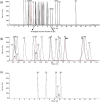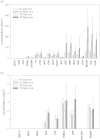Fast analysis of 29 polycyclic aromatic hydrocarbons (PAHs) and nitro-PAHs with ultra-high performance liquid chromatography-atmospheric pressure photoionization-tandem mass spectrometry
- PMID: 26265155
- PMCID: PMC4532996
- DOI: 10.1038/srep12992
Fast analysis of 29 polycyclic aromatic hydrocarbons (PAHs) and nitro-PAHs with ultra-high performance liquid chromatography-atmospheric pressure photoionization-tandem mass spectrometry
Abstract
Polycyclic aromatic hydrocarbons (PAHs) and nitro-PAHs are ubiquitous in the environment. Some of them are probable carcinogens and some are source markers. This work presents an ultra-high performance liquid chromatography-atmospheric pressure photoionization-tandem mass spectrometry (UHPLC-APPI-MS/MS) method for simultaneous analysis of 20 PAHs and nine nitro-PAHs. These compounds are separated in 15 minutes in the positive mode and 11 minutes in the negative mode, one half of GC/MS analysis time. Two pairs of precursor/product ions are offered, which is essential for confirmation. This method separates and quantifies benzo[a]pyrene (the most toxic PAHs) and non-priority benzo[e]pyrene (isomers, little toxicity) to avoid overestimation of toxin levels, demonstrating its importance for health-related researches. With 0.5% 2,4-difluoroanisole in chlorobenzene as the dopant, limits of detection of PAHs except acenaphthylene and those of nitro-PAHs except 2-nitrofluoranthene are below 10 pg and 3 pg, respectively, mostly lower than or comparable to those reported using LC-related systems. The responses were linear over two orders of magnitude with fairly good accuracy and precision. Certified reference materials and real aerosol samples were analyzed to demonstrate its applicability. This fast, sensitive, and reliable method is the first UHPLC-APPI-MS/MS method capable of simultaneously analyzing 29 environmentally and toxicologically important PAHs and nitro-PAHs.
Figures


References
-
- ATSDR. Toxicological profile for polycyclic Aromatic Hydrocarbons (PAHs), update. Agency for Toxic Substances and Drug Registry (ATSDR), Washington, Chap 1, pages 1–5 (1995). - PubMed
-
- ATSDR. Toxicological profile for polycyclic Aromatic Hydrocarbons (PAHs), update. Agency for Toxic Substances and Drug Registry (ATSDR), Washington, Chap 2, pages 11–207 (1995). - PubMed
-
- WHO/IARC. Some non-heterocyclic polycyclic aromatic hydrocarbons and some related exposures/IARC Working Group on the Evaluation of Carcinogenic Risks to Humans. IARC monographs on the evaluation of carcinogenic risks to humans; v. 92. International Agency for Research on Cancer (IARC), Lyon, France, pages 20–26 (2005). - PMC - PubMed
Publication types
MeSH terms
Substances
LinkOut - more resources
Full Text Sources
Other Literature Sources
Miscellaneous

